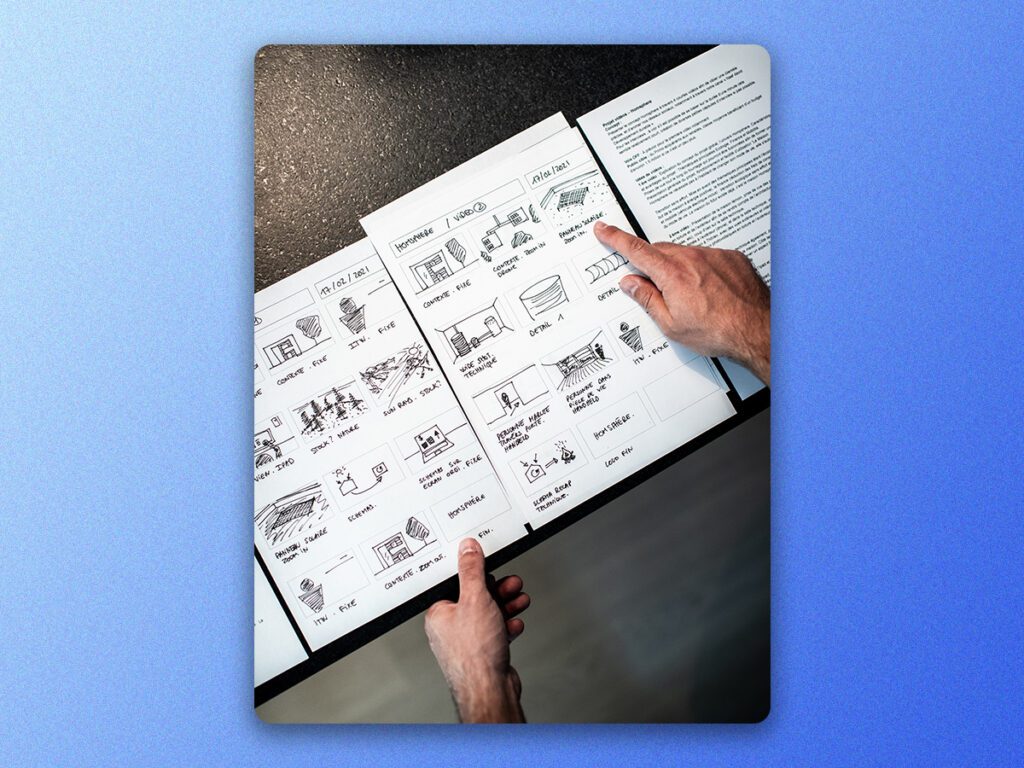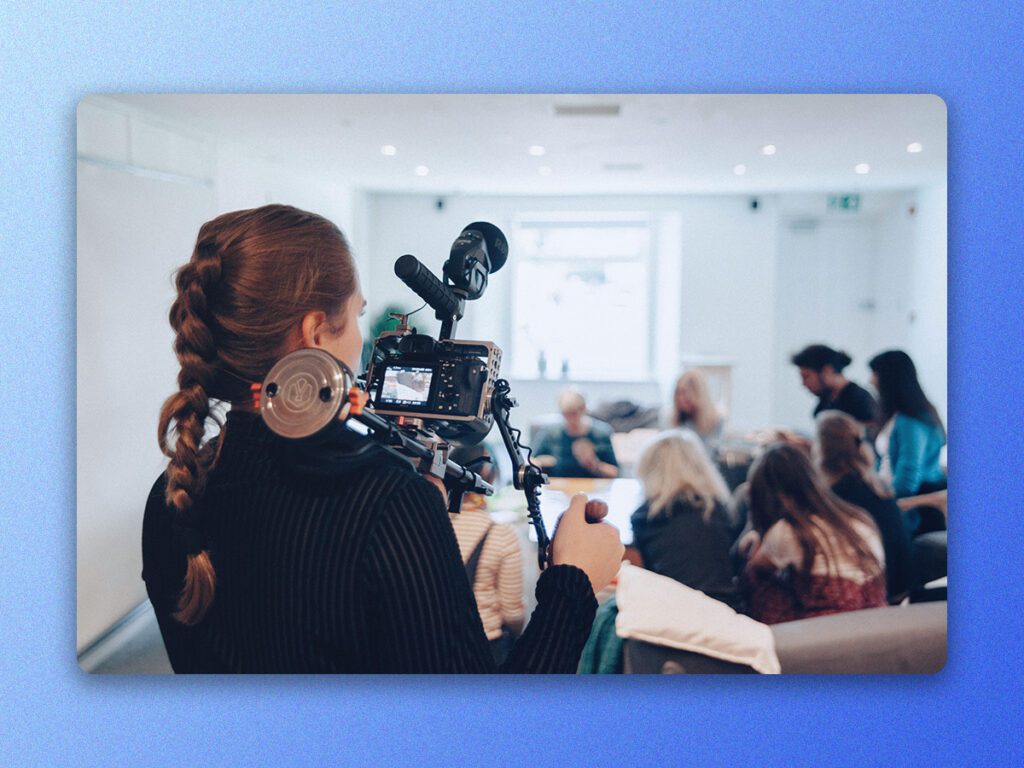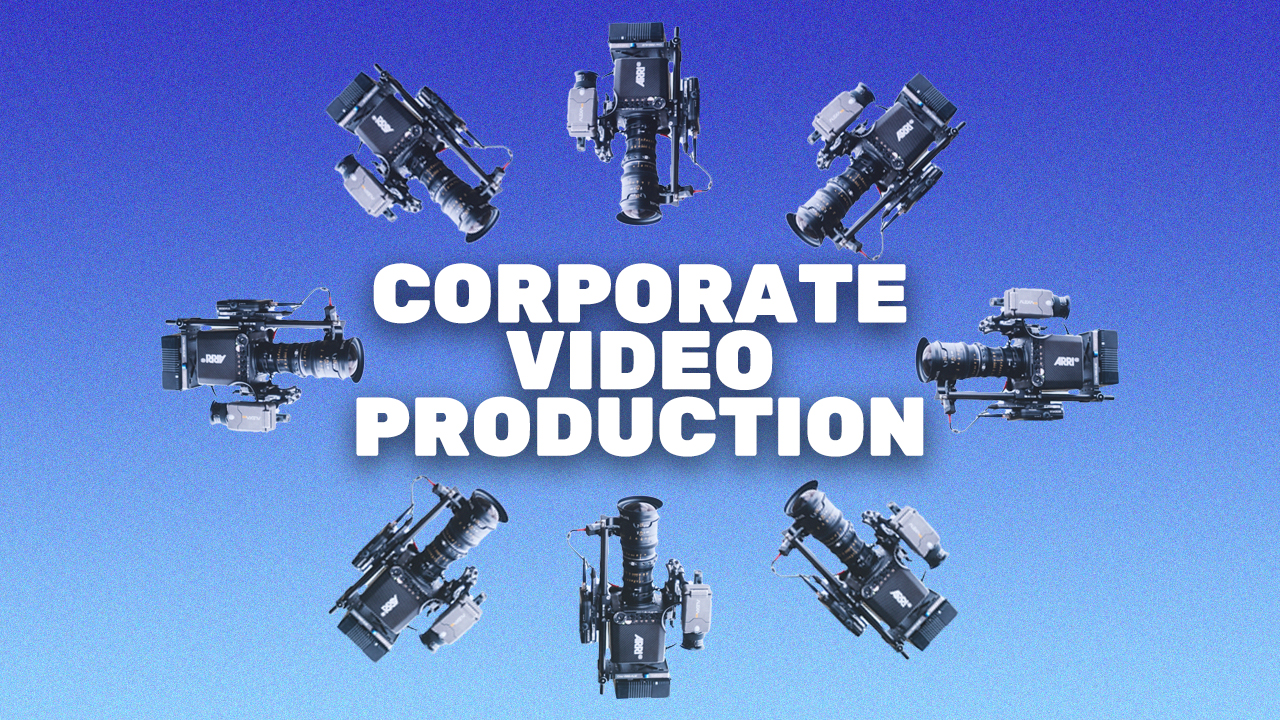Ready to dive into the world of corporate video production? This comprehensive guide unpacks everything you need to know, from types of corporate videos to the key roles involved and even budgeting. Boost your brand, engage your audience, and achieve your business goals with high-quality video content.

What Is Corporate Video Production?
Want to elevate your brand with compelling visual content? This powerful tool helps your company share its message, train staff, and connect with customers. Stick around to gain a clear understanding of what corporate video production really means.
Corporate video production is the art and science of creating visual content specifically for business use. Unlike casual videos, these aim to uphold the professional image of a company. The content often targets a specific audience and serves various purposes, including marketing, internal communication, and training.
Corporate videos can come in many formats—product demos, interviews with executives, tutorials, and more. Companies use these videos on their websites, at trade shows, or during internal meetings to convey messages effectively and engagingly. Quality matters here. A well-made corporate video reflects positively on your brand, while a poor one can do the opposite.
Why You Should Care About Video Production for Your Business
Wondering why video production matters for your business? From improved customer engagement to a robust marketing strategy, the benefits are numerous.
In today’s digital landscape, video content reigns supreme. It captivates attention more than any other form of content and is shareable, thus expanding your reach. In the US alone, 244.4 million people watched video content of some kind.
A well-produced video can enhance your brand image and drive sales by effectively conveying your company’s mission, products, or services. It can also serve internal purposes, like employee training or updates, saving you time and resources in the long run. By neglecting video production, you could miss out on a powerful tool that boosts visibility, engagement, and ultimately, revenue.
Types of Corporate Video Production
Navigating the world of corporate video? Knowing the different types helps in making informed decisions. This section breaks down the main categories of corporate videos, from product demos to testimonials.
Product Demos
Product demo videos showcase your product in action, highlighting its features and benefits. These videos are usually concise, aiming to capture and hold the viewer’s attention. Companies often place product demos on their websites, within email campaigns, or as part of a sales presentation. These videos serve as virtual sales pitches that viewers can watch at their convenience.
Testimonials
Nothing builds trust like a word from satisfied customers. Testimonial videos feature interviews with people who have used your product or service and found value in it. The natural, candid nature of these videos often resonates well with audiences, offering social proof that your products or services are worth the investment.
Training and Educational Videos
Training videos aim to educate employees or customers about certain procedures or how to use a specific product. These videos often replace or complement traditional manuals and in-person training sessions. By using visuals and audio, training videos can enhance comprehension and retention of complex topics.
Company Culture Videos
These videos give a glimpse into the life inside your organization. Company culture videos often include interviews with staff, tours of the workplace, and highlights of company events. These videos aim to attract potential employees and also to humanize the brand for consumers.
Event Summaries
If your company hosts or participates in events, an event summary video captures the highlights. This includes keynote speeches, interviews with attendees, and general ambiance shots. Companies use these videos to share the event experience with those who couldn’t attend, or to promote future events.
By understanding these categories, you’ll better identify the type of video that aligns with your goals, helping your company engage effectively with its target audience.
The Process of Corporate Video Production, Explained
Curious about how corporate videos go from concept to final product? It’s more than just hitting ‘record’; it involves careful planning, execution, and editing. Video production is often a far more involved and challenging process than many assume.
Pre-Production
The pre-production phase sets the stage for a successful video. It involves everything that happens before the camera starts rolling. The first step is defining the objective of the video. Are you aiming to introduce a new product, or perhaps convey company culture? Once the objective is clear, the next steps include scriptwriting, storyboarding, and assembling a team of professionals like directors, producers, and videographers.
Budgeting also takes place in this stage. A budget outlines the resources needed, from equipment rentals to post-production costs. Once the budget is set, scouting and securing locations come next. Some videos might require permissions or permits for shooting at certain locations.
Scripting and storyboarding are also an important part of this phase. Good planning leads to good video content – there’s no way around it. These days, however, scriptwriting can be enhanced and streamlined with the use of ethical AI tools.
All these steps collectively form the foundation upon which a compelling corporate video is built.
Tips and Secrets:
- Keep the video objective top of mind; it guides every decision.
- Use scriptwriting software to streamline the writing process.
- Allocate extra budget for unexpected costs.
- Always have a Plan B for locations, in case permits fall through or weather interferes.

Production
With pre-production all set, it’s time to get those cameras rolling. Production is where all the planning gets put into action. On the set, the director leads the crew and talent, ensuring each scene is shot according to the storyboard or script. Lighting, audio, and camera settings all need precise adjustment to capture the best possible footage.
If using actors or presenters, they’ll likely rehearse their lines before the actual shoot. Teleprompters can also come in handy here, making it easier for individuals to deliver their lines while maintaining eye contact with the camera. Production days can be long and require a lot of focus and energy from everyone involved. Once all scenes are shot, a wrap-up meeting usually takes place to review what was accomplished and to prepare for the post-production phase.
Tips and Secrets:
- Use teleprompters for long scripts or non-professional actors.
- Maintain backups of all footage to avoid loss.
- Pay attention to sound quality; bad audio can ruin a good video.
- Keep track of time to avoid going over budget.
- Always capture extra footage (B-roll) for added flexibility during editing.

Post-Production
Once all the footage is in the can, the post-production phase begins. This is where the video really comes to life. Editing starts with sorting through the hours of footage to pick the best shots. Special effects, text overlays, and color corrections are also added during this stage. Sound mixing is crucial as well, ensuring that audio levels are balanced and background noises are minimized.
Music is often added to enhance the video’s emotional impact. Once the initial version is edited, it typically goes through several rounds of revisions. Feedback from various stakeholders can lead to changes in the final cut. Eventually, the video is finalized and prepared for distribution across the chosen platforms.
Tips and Secrets:
- Use professional editing software for the best results.
- Don’t skip the review process; multiple eyes catch multiple mistakes.
- Keep file formats in mind, different platforms may have different requirements.
- Archive raw footage; you never know when it might be useful for future projects.
- Make use of stock music or sound effects, but always check licensing requirements first.

The Roles in Corporate Video Production
Wondering who’s behind the magic of a well-crafted corporate video? This section illuminates the key players in the video production process. From the company’s internal team to the on-set professionals, understanding these roles will give you a comprehensive view of what it takes to produce a high-quality video.
Project Manager
In a corporate setting, the project manager oversees the entire video production project. This role involves setting deadlines, managing budgets, and ensuring that all departments involved are aligned with the video’s objectives. The project manager serves as the main point of contact between the corporate team and the production company, making sure everyone stays on the same page.
Scriptwriter
A scriptwriter crafts the script that serves as the backbone of the video. This involves understanding the target audience and the message that the company wants to convey. In close collaboration with the project manager and sometimes even executives, the scriptwriter lays out the spoken words, the visual elements, and the general flow of the video.
Director
The director brings the script to life, coordinating with the camera operators, lighting technicians, and actors. The director’s vision influences the look and feel of the video, from shot selection to pacing. Decision-making on the set often falls on the director, who has the final say on how scenes are shot and acted out.
Videographer/Camera Operator
The videographer or camera operator handles the equipment that captures the visual elements. Mastery of the camera settings, angles, and movements is crucial for this role. In some smaller productions, the videographer may also assume additional responsibilities like lighting and sound.
Editor
Once all the footage is captured, the editor pieces it together in post-production. This involves not only selecting the best shots but also implementing visual effects, transitions, and sound editing. The editor works closely with the director to make sure the final product matches the envisioned concept.
Corporate Stakeholders
Last but not least, various stakeholders within the company, such as marketing managers or executives, have a say in the video production process. They often provide initial ideas, approve budgets, and give feedback on the final product. Their input ensures that the video aligns with broader corporate goals and brand standards.
How Much Does Corporate Video Production Cost?
Curious about the financial aspect of creating a corporate video? Various factors influence the final price, from pre-production to post-production. Keep reading to get a better understanding of what to budget for your project.
The cost of corporate video production can vary widely depending on several factors, including the complexity of the project, the duration of the video, and the professionals you hire. Some small-scale projects might only require a budget of a few thousand dollars, especially if you are doing everything in-house.
More elaborate videos involving experienced professionals, high-quality equipment, and post-production editing can run into the tens of thousands of dollars. It’s crucial to set a budget that aligns with your objectives and the quality you aim to achieve.
The Final Cut on Corporate Video Production
Navigating the realm of corporate video production might initially seem daunting, but the rewards are compelling. Understanding the different types, the production process, and the roles involved allows for a more informed approach to using this versatile tool.
Whether you aim to enhance customer engagement, train employees, or bolster your marketing strategy, corporate videos offer a dynamic way to convey your brand’s message. With the right planning and execution, your business stands to benefit significantly from incorporating high-quality video content.

